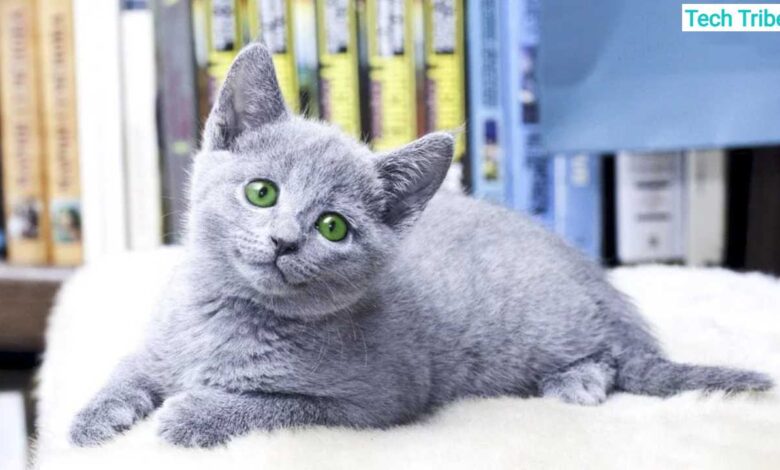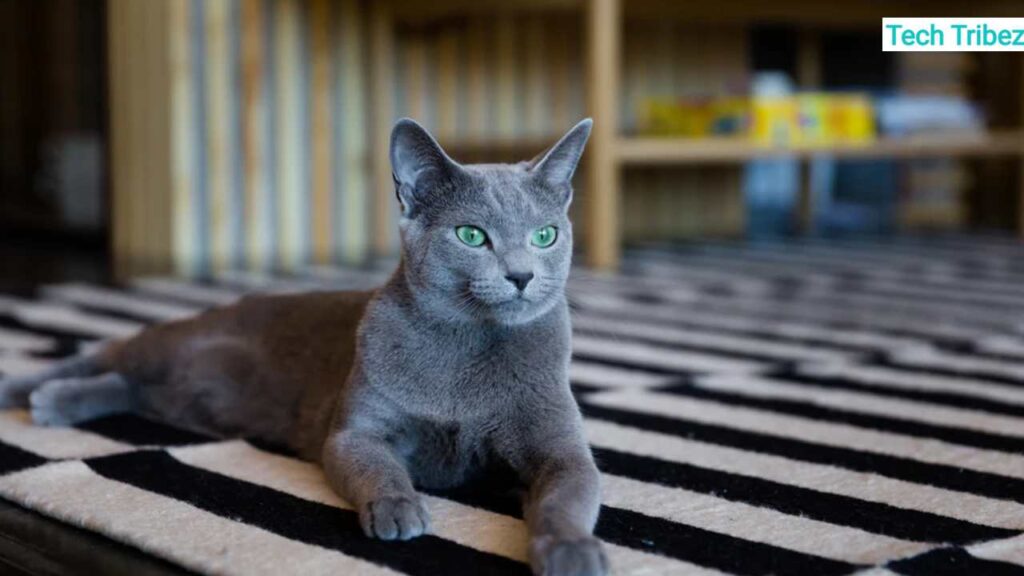10 Interesting Facts About Russian Blue Cat

Russian Blue cats are undoubtedly some of the most famous cats in the world due to their appearance and temper. This article explores ten astonishing points of the Russian Blue cat, which will clarify this breed to the tiniest detail.
History and Origin of the Russian Blue Cat
The origin of the Russian Blue Cat is surrounded by mystery and a little exoticism. Despite that, these cats are believed to have been explicitly bred from the cold regions of Russia and are said to be related to the cats owned by Russian Czars. The first records of the Russian Blue date to the second half of the nineteenth century in the Russian seaport town of Arkhangelsk; hence, their original name, the Archangel Cats. They were introduced to Europe by sailors and bred with the locals before being imported to the United States.
One will wonder how they have a blue-gray coat and green eyes, making them look royal and majestic. The Russian Blue breed was first seen at the inaugural cat show in London in 1875. This is because of their grace and unique features that have made them loved by many, especially those in cat shows and pet lovers. Today, all the major cat registries have accepted the Russian Blues, and it remains one of the most enigmatic cats.
Distinctive Features of the Russian Blue
An aesthetically pleasing quality that makes the Russian Blue cat rather exotic is its coat. These cats are moderately sized, have lean muscles, and possess a body structure best described as supple. Its fur is its trademark characteristic; the Russian Blue has a short, dense, thick double layer with a softness similar to velvet. It is a medium-large dog, mainly silver-blue, although the breed has black and blue varieties. This coat also gives a shiny look and acts as a shield against the extreme weather conditions of the regions it belongs to.
The Russian blue eyes are also unique. They are large, round, and bright green, perfectly complementing their blue coat. The ears are big and erect with pointed tips, giving the dog a cheerful and attentive look. They have a splendid appearance and are well-developed athletically, appearing taller than they are. According to the breed standard, they should give an impression of a ‘smiling’ face, and their disposition is pleasant.
The Temperament of the Russian Blue Cat
Pets like Russian blue cats are friendly and usually recommended for families or anyone with kids. It’s primarily timid when dealing with unfamiliar people, for instance, people of different ages and sexes, yet it will fiercely defend its own. This breed is loyal and will accompany its master from one room to another. It will always want to be with the master. There are few workaholics, but they are happy and willing participants in the households. Coat: Russian Blues are intelligent and curious and like to play for most of their life regardless of age.

Yet, a peculiar trait of Russian Blues is that they are independent simultaneously. They are happy being on their own, and unlike some other animals, they do not show signs of stress or distress when their owners are not around. This makes them suitable for those who may be in an office or any place that would only let them stay at home sometimes. Russian Blues are also very vocal but not loud; they do not talk much but purr softly and chirp on rare occasions. This characteristic makes them ideal for families, single, and older adults who are using the services of companies.
Health and Lifespan of Russian Blue Cats
Russian Blue cats have very sound health and bodily build, and their longevity ranges between 15 and 20 years. They are healthy and have not suffered from many congenital diseases common in other breeds. Nevertheless, Breed Predispositions, like any other cat breeds, are susceptible to obesity, dental diseases, and urinary system diseases. These requirements include routine health checkups and vaccinations, a balanced diet, and good dental health.
Russian Blues are also considered a healthy breed that tends to resist the cold because of the thick undercoat. That said, owners should pay attention to the physical environment that the cat is in and the existence, cleanliness, and comfort of its substratum. Regular vaccinations, internal and external parasite treatments, and other standard health checkups must be administered and should be a part of an otherwise healthy Russian Blues life expectancy. But if taken care of adequately and combined with these vices, these cats can lead a healthy life as pets.
Why Russian Blue Cats Are Hypoallergenic
Another reason for the Russian Blue’s popularity is that it is said to be a hypoallergenic cat. Although no cat is entirely hypoallergenic, Russian Blues cause less Fel d 1 glycoprotein that is present in cat saliva. It subsequently generates a considerably lower degree of allergens than other cats that experience heavier double coats, which safeguard for allergies in human beings and act to retain the cat’s insulating dander. It should be mentioned that cats’ presence may be different because people’s reactions to these animals can be different too – something that is ok for one person is painful for another.
Additional measures that will help prevent allergens include grooming, vacuuming, and air purification. For those who are allergic, it is advisable to interact with the Russian Blue before getting one as a pet to know the level of discomfort caused by the animal. Russian Blue is a moderately shedding cat, and individuals with allergy problems often discover that they can easily tolerate this breed and thus can own beautiful and friendly companion cats.
Grooming Tips for Your Russian Blue
Russian Blue cats’ grooming process is relatively easy. They possess short, dense fur, are seldom prone to tangles, and need weekly grooming for some ear licking and removing dead hairs. Although their coat looks very thick, the Russian Blues are not too much of a bother regarding the shedding factor, which is always a plus for those called ‘couch potatoes.’
Taking your Russian Blue for a cat grooming session also benefits their fur and fortifies affection between you and your cat. It is also advisable to look for skin rashes or parasites at this age because they also affect a young child. Teeth care is also crucial in grooming a Russian blue and requires dental care. There are many ways the problem of dental disease can be prevented, including giving dental treats or brushing the teeth often. Bathe them regularly, and it is advised that their nails should also be trimmed from time to time and their ears cleaned.
Diet and Nutrition for a Healthy Russian Blue
Proper nutrition is essential for the Russian Blue’s health and longevity, so you should feed them well. These cats are particularly prone to obesity if their diet is rich; it is, therefore, advisable to regulate the amount of food they are given to avoid cases of obesity due to eating large amounts of food with little or no activity. The athletes require their foods to have plenty of good-quality protein, moderate fats, and the most minor amounts of carbohydrates needed for their weight and daily activities.

Care must be taken while selecting these felines, like wet and dry cat foods, as they should not be rich in fillers and artificial additives. The cats’ water should also be fresh as they should consume water to avoid urinary tract problems that are frequent in cats. It is therefore advised that you consult a veterinarian to help you put the right diet plan in place for your Russian Blue, depending on their age, weight, and activity level.
Training Your Russian Blue: Tips and Tricks
It can be surprising, but it is well-known that Russian Blue cats are brilliant and can be taught tricks and commands. They are also easily motivated due to their curious nature and the fact that they like pleasing people; they can be trained through positive reinforcement. The three basic obedience commands that any guide or diva can easily teach their dog include sit, stay, and come, and this training involves the use of treats, praise, and time. To cater to the need to explore new environments, they can be trained to use a leash when walking.
Like most cats, a Russian Blue will need to be mentally stimulated, and toys such as toys and puzzle feeders work well in encouraging the cat. These cats also like to play ball, the same as dogs, and such behavior is relatively rare among cats. Russian Blues require a lot of patience during training since they favor positive reinforcement more than punishment. As research shows, these intelligent cats can be trained to perform various stunts and follow several instructions, making them enjoyable to watch.
The Unique Eyes of the Russian Blue Cat
One of the most attractive facts about this breed is its ability to have green eyes. The kittens are usually born with yellow eyes, which at a certain age become green; these kittens are the Russian Blues. Their eyes are intensely green when they become adults, contrasting with a silver-blue fur coat. One of their distinguishing characteristics is their level of pigmentation, and the odd eye color only enhances the breed’s beauty.

Russian Blues have huge round eyes, unlike any other breed, making the cats’ gaze appear doleful and bright. The eyes of this breed are usually said to be calm and thoughtful, which correlates with the breed’s temperament, which can be described as shy and reserved. The eyes are also large and separate, giving them the friendly appearance associated with cute eyes. These are not only aesthetically appealing eyes, but these eyes also speak a lot about the breed – its friendly and obedient temperament.
Why Russian Blue Cats Make Great Companions
As mentioned above, Russian blue cats are good pets for numerous reasons. They are friendly and well-suited for families with kids, single people, and their grandparents. They are most friendly and affectionate but not very energetic, requiring constant attention; they are the most suitable for people who love to have pets but do not have so much time to devote to them. Other features of Russian Blue kittens include independence, which makes the cats entertain themselves when their owners are occupied or at different times.
This is good for people who live in apartments or have other animals to care for. Russian Blues are also quite wise and active, so they are always fun to be around, especially with their playful curiosity. Due to their low fur shedding, they are a favorite for those with allergies, and therefore, more families can adopt a cat pet without suffering the discomforts that come with allergies.
Conclusion
Russian blue cats are some of the most beautiful and unusual cats; every cat lover will hear about them. These are reasons why getting Russian Blues as pets is an excellent idea. They originate from Russia, look different, and are so affectionate. Whether you are impressed with their beautiful green eyes, or they are friendly, or you love the fact that they are hypoallergenic, a Russian Blue can be a great friend for many years.
FAQs About Russian Blue Cats
Are Russian Blue cats genuinely hypoallergenic?
However, Russian Blue cats are low-shedding and produce little Fel d 1 protein, which means they are not allergenic. Nevertheless, there isn’t such thing as a hypoallergenic cat; therefore, every person’s allergies may differ.
How much grooming does a Russian Blue need?
Russian blue cats are easy to groom. Bathing: Russian blue cats must be brushed at least once weekly, depending on their coat type. However, they are considered low shedders and do not need to be bathed often.
Are Russian Blue cats good with children and other pets?
In general, Russian Blues are fine around children and other pets. They are peaceful and take their time to adjust to family needs, and thus, they are recommended for families. However, they tend to be fussy, especially when introduced to new strangers, until they get familiar with them.
How long do Russian Blue cats typically live?
Russian Blue cats are known to live for about 15 to years, given that they are well taken care of. Thus, they are among the longest-lived cats.
Do Russian Blue cats need a lot of exercise?
Despite being active and enjoying play, Russian Blues are generally inactive and only need a little activity. To emerge as healthy cats, they should be given toys and scratching posts and sometimes played with.
What kind of diet is best for a Russian Blue cat?
Like all cats, Russian Blues should be fed a high-quality cat diet containing adequate protein, moderate fat, and lower carbohydrates. Do not overfeed them, as they can become obese quickly. Dedicating some time to play with them can lead to some of them gaining excessive weight, thus becoming obese.
Can Russian Blue cats be trained?
Yes, Russian Blue cats are intelligent creatures, and if desired, one can teach them various tricks and commands by rewarding them.
Are Russian Blue cats vocal?
Regarding the behavior of Russian Blue cats, they are usually known to be quiet and soft-voiced. They are not very aggressive and only make loud sounds like purring and sweet bird-like tweeting.
How do Russian Blue cats handle being alone?
Russian Blues are not aggressive or noisy and can be left alone for a certain number of hours. They do not have to show separation anxiety, making them more appropriate for people who spend most of the day outside the house.
What makes Russian Blue Cats unique?
Another exciting thing about the Russian Blues is their gorgeous blue-gray coat, their vivid green eyes, the fact that they are hypoallergenic, and their friendly personalities. It is attributed to them due to their loyalty, intelligence, and low care ratio, thus qualifying them as excellent companions.



